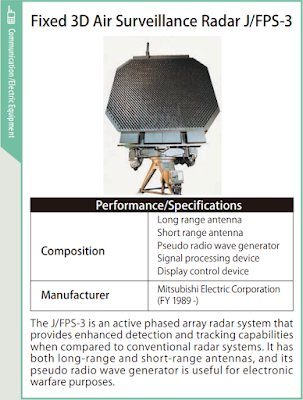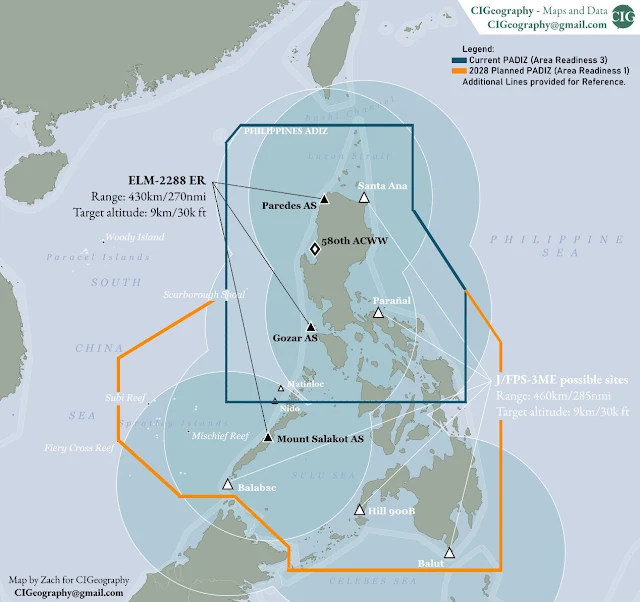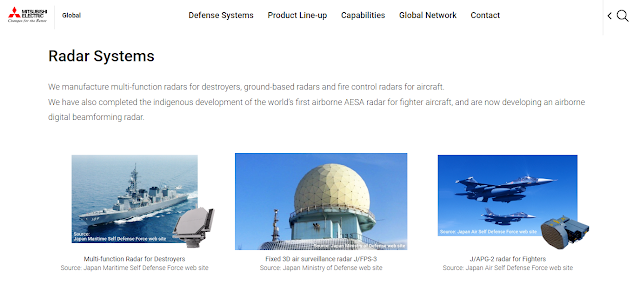Through the years, the Philippine Air Force strives to improve its capabilities, especially in regarding about the step-by-step implementation of the Philippine Air Defense Identification Zone or PADIZ, which itself comes with intricate systems of fighter jet deployment, along with other essential units like ground-based air defense system batteries and air search radars.
In this discussion, we will talk about one of those essential units that gives a 360-degree airspace coverage that covers a significant portion of the Philippine Air Space, in which with sufficient numbers will help the air service branch attain its aim of getting the PADIZ into Area Readiness 1.
DISCUSSION OVERVIEW
 |
| Personnel belonging to the Philippine Air Force observe a Japanese Air Self-Defense Force radar station. Image Source. |
Last October 2022, a report released that an announcement has disclosed from Mitsubishi Electric regarding the completion of the first of its four (4) radar components intended to the Philippine Air Force. Apparently, these radars serve as Japan's first export of defense hardware since they relax their restrictions in relation to the provisions on arms export.
The move will help the Philippine Air Force improve its air defense capabilities, especially on threat detection within the country's airspace, as this augments the three (3) existing ELTA ELM-2288ER AD-STAR air search radar coming from Israel. This comes on top of another layer of radar coverage provided by the air service branch's SPYDER-MR Ground-Based Air Defense Systems of RAFAEL Advanced Systems Ltd., also from Israel.
These radar components are a product of the Philippine Air Force's Air Surveillance System Acquisition Project, whereby they provide at least three (3) J/FPS-3ME and a mobile, truck-mounted J/TPS-P14ME air surveillance radar, a break from the logistical issues that may come with having at least two types of air search radar systems. Despite the issue mentioned, expectations are high that several Philippine Air Force radar stations across the country may get more functional with these capabilities coming at hand, or at the point that more radar sites get erected along the way.
The air search radars provided by Japan under an acquisition deal comes as the bilateral relations between both maritime countries of East Asia get warmer than ever, as the former provides other tools for the Philippine government to use and enforce its maritime rights, such as both the Parola-class Multirole Response Vessels and the larger Teresa Magbanua-class Multirole Response Vessels of the Philippine Coast Guard.
Take note that both Japan and the Philippines have a commonality, especially in dealing with China, with the communist regional superpower claims both the Senkaku island chains of Japan and the Kalayaan Island Group plus Panatag Shoal of the Philippines as its own, while the geographic nature of both maritime nations, along with Taiwan, forms the first island chain that contains China from accessing the Pacific Ocean in an event of war.
ABOUT MITSUBISHI ELECTRIC
 |
| Mitsubishi Electric's main website. Link here. |
The J/FPS-3 air surveillance radar that the Philippine Air Force purchased from Japan is a product of a Japanese technology firm, Mitsubishi Electric, whereby it has its own line-up of defense systems. Take note that the product of this Japanese firm, aside from its other defense system lineup, purposely aims for the requirements set by the Japan Self-Defense Force, until they became the first Japanese company to export defense equipment to an overseas customer, which in this case is the Philippine Air Force.
As a primary defense manufacturer in Japan, Mitsubishi Electric provides military equipment to the Japanese Ministry of Defense and they support the country's desire for enhancing its overall deterrence, especially during this time when tensions are getting hotter in the Indo-Pacific region. The company itself has established as a spinoff of Mitsubishi Heavy Industries, the one responsible for overseeing Mitsubishi Shipbuilding Co., who produces the Teresa Magbanua-class Multirole Response Vessels for the Philippine Coast Guard.
Its origins came from the same original Nagasaki Shipyard and Machinery Works where Mitsubishi started as the Mitsubishi Shipping Co. that became Mitsubishi Heavy Industries later on in the 1870s, with the company's name changed to Mitsubishi Shokai during that time. It was in 1921 when Mitsubishi Electric became an entity of its own under Mitsubishi Group, when a factory in Kobe, Japan has established primarily focusing on producing electric motors for ocean vessels and eventually, electronics as they grow through time.
Mitsubishi Electric, at its current iteration, comes with multiple products and solutions it can offer, ranging from its national defense clients like the government with its air surveillance radar offer that the Philippine Air Force currently receives, to consumer goods like air conditioning systems for both residential and commercial uses, to escalators and elevators for high commercial establishments like malls and highrise office and residential buildings.
With its continuous pursuance in innovation and also being the leading research and development firm within Japan and globally, Mitsubishi Electric's products comes with its sophistication and reliability, especially that the air surveillance radars that the Philippine Air Force receives are also the ones that provide air defense coverage for the Japanese Air Defense Identification Zone.
DEVELOPMENT
 |
| As described by Japan Ministry of Defense. Check PDF File here. |
According to this information provided in the Mitsubishi Electric website for the J/FPS-3 air surveillance radar, that these sophisticated units made by a Japanese electronics company has long served Japan's Air Self Defense Force since 1989 and since then continuously being in operation for 30 years covering Japan's airspace, even with more sophisticated versions coming in mind like the newer J/FPS-5 radars.
It all started when the Japan Air Self-Defense Force upgraded its radar stations, starting in Kyoto prefecture near Cape Kyogamisaki where the American-made AN/FPS-20B and AN/FPS-6 radars are situated, when their leadership opts to upgrade the facility with the J/FPS-3 radar, until the station has commissioned in 1992. Japanese airspace during that time has monitored by the older J/FPS-2 air surveillance radars.
The J/FPS-3 is the third iteration of the Japanese indigenously developed air surveillance radars, in which it can trace back to the J/FPS-1, when the first operations for such radar technology took place in the early 1970s. While the Japanese have researched and work for the development of the J/FPS-1, its operation is not without problems as there are maintenance problems with the system and retrofits have apparently got radar stations upgraded to the newer J/FPS-2 radars during that time.
Regarding the J/FPS-3 air surveillance radar, its overall capability and operability test has taken place in the 1980s when Mitsubishi Electric has selected for the design and manufacturing of the air surveillance system, with more evaluations and trial operations continue until 1995 in Cape Kyogamisaki, until the total number of orders specified has completed by the Japanese firm in 1999.
Since then, the J/FPS-3 air surveillance radar became one of the mainstay radar platforms that oversee and monitor the Japanese airspace, and its reliability and continuous development made by Mitsubishi Electric is now trickling down to the Philippine Air Force, being the first export user of these radars, as its capabilities being the next sub-topic of this overall discussion.
CAPABILITIES
 |
| This is a map with radar coverage of both J/FPS-3ME and Israel's ELM-2288ER air surveillance radars. (c) CI Geography, with edits from Pitz Defense Analysis for reference. |
The map above shows the coverage of all prospective radar stations that the Philippine Air Force operates, should all the radars coming from Japan have deployed over the country over the existing Israeli-made ELM-2288ER air surveillance radars deployed in the country's western part facing the West Philippine Sea, with the expected coverage of at least 100% of the current Philippine Air Defense Identification Zone or PADIZ under Area Readiness 3 and at least 80-90% of the slated 2028 PADIZ under Area Readiness 1.
One thing to highlight regarding its capability is that this type of radar is what we consider as Active Electronically Scanned Array or AESA radars, a type of radar detection system where it is a sophisticated system capable of detecting enemy aircraft and unmanned aerial vehicles at long distances, while it is far more resistant from any radar-related electronic jamming attempts made by any intruders who wants to inflict harm upon entering a designated airspace at the event of war.
Speaking of capabilities, there is basically no difference between the J/FPS-3ME and the ELM-2288 ER air surveillance radars in terms of target altitude range which is at least 30,000 feet, basically the lower stratosphere where the cruising altitude for most passenger aircraft lies on. While there are similarities between the two different air surveillance radars for this manner, the J/FPS-3ME actually has the larger horizontal range of around 460 kilometers or 285 nautical miles or at least 30 kilometers or 15 nautical miles more than the Israel-made air surveillance radars deployed.
Another thing to check on is the areas where the J/FPS-3 are possibly getting deployed, although it is not final yet as the locations can still change, at the discretion of the leadership within the Philippine Air Force. The locations provided on the map, aside from the coverage given within the Philippine Air Defense Identification Zone, also cover areas outside of the said designated Philippine airspace, such as portions of the Philippine Rise (Benham Rise), Celebes Seas and waters within Indonesian territorial waters, and the entirety of Sabah and portions of Brunei Darussalam.
With the overlapping radar coverage, especially with the deployment of J/FPS-3ME air surveillance radar over the Israeli ELM-2288 ER radars already deployed in key Philippine air stations across the country’s western portion facing the West Philippine Sea, the air service branch has now gotten the almost 100% monitoring of the Philippine airspace against intruders, with other components of the Philippine Air Defense Identification Zone like adding more ground-based air defense and multirole fighter jets for interdiction needing more materialization.
IN SUMMARY
 |
| Mitsubishi Electric produces different radar variants for all applications. Screenshot from the Mitsubishi Electric website. |
Having fully functional radar stations deployed across the country that have a maximum coverage of at least 400 kilometers is a significant gain for the likes of the Philippine Air Force, as it now goes further beyond its current Philippine Air Defense Identification Zone or PADIZ under Area Readiness 3 and is now about to achieve its 2028 aims of getting the 100% radar coverage under Area Readiness 1 of the expanded PADIZ.
This comes as both Japan and the Philippines sought to attain warm bilateral relations in an essence that the cooperation goes further to the field of defense, as the former slowly allows itself to export military hardware to other nations, a feat that has considered as outright impossible one or two decades ago, given Japan’s arms export bans during that time until it has revised into the current arrangement that have made the J/FPS-3 deal possible.
Given this trend, it may not be that surprising if Japan’s arms export prospects continue to increase, as well as the trend of ever-growing relations this country has with the Philippines, especially with the reports coming around with the possibility of providing the Philippine Army’s Aviation ‘Hiraya’ Regiment of UH-1J Huey Combat Utility Helicopters and possibly, the AH-1S Cobra Attack Helicopters as the Japanese defense doctrine changes for a more technologically based approach of using unmanned aerial systems.
With the radar coverage for the Philippine Air Defense Identification Zone almost complete, all that remains is the Philippine Air Force’s push for having more fighter aircraft to intercept intruders as part of implementation of its airspace, as the air service branch’s Multirole Fighter Jet Acquisition Project almost coming to a near conclusion whereby a platform between SAAB’s JAS-39 Gripen and Lockheed Martin’s F-16 Viper might find its way in serving the squadrons within the organization.
It is a welcoming development for both the Philippines and Japan in getting the deal on the J/FPS-3 air surveillance radar deal possible, as both countries see defense cooperation as a much-needed diplomacy as both countries shares common issues in dealing with a regional superpower such as China, who pushes its national interest in claiming Kalayaan Island Group and Panatag Shoal in the West Philippine Sea, and the Senkaku islands in the East China Sea as theirs.
For the Philippines, this is just part of the ever-growing prospect and interest regarding the importance of national defense in its entirety, especially now that the current administration shows support for its current modernization efforts, such as this development in pushing Philippine Air Force’s modernization even further as the tensions in the West Philippine Sea intensify.













No comments:
Post a Comment